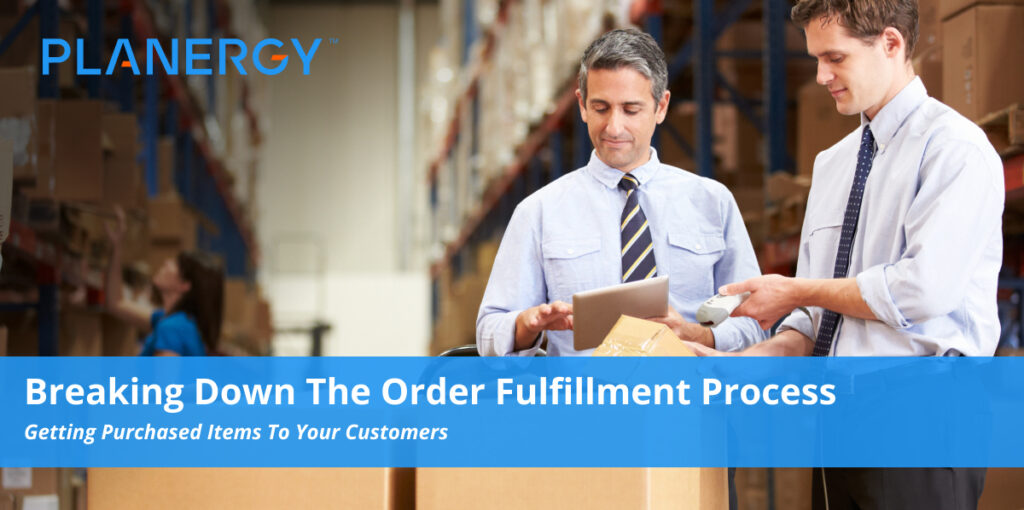Order fulfillment is part of the broader supply chain process. It is the process of receiving, processing, and delivering orders to your end customers.
It’s possible to handle fulfillment in-house or to outsource it to a third-party fulfillment service that handles the process for you.
If you outsource it to a third-party, as can be done with services such as Fulfilled by Amazon, you’ll ship your inventory to Amazon, where it will be stored in their warehouse until sales are made.
In exchange for not having to store and manage inventory yourself, you’ll pay a fee from each one of those sales.
To maintain quality control and keep as much profit as possible, many smaller operations opt to handle their own order fulfillment process.
The Basics of Order Fulfillment For Businesses
Order fulfillment varies widely based on industry and can become quite complex.
E-commerce order fulfillment for a small online store handling small volume online orders can be very different to a large organization with a dedicated fulfillment center.
Other factors, such as order volume, if it is a business-to-business (B2B) or business-to-consumer (B2C) transaction, or if dropshipping will be part of the process, can add further complications.
In some instances, production on products ordered doesn’t begin until a customer order is placed. In those scenarios, the fulfillment process can vary significantly.
What Happens in the Receiving Phase
First, you receive inventory from suppliers and manufacturers at your warehouse. You’ll:
- Count all the items to make sure what you receive matches what you ordered.
- Check to make sure no items have been damaged in transit.
- Add data to your warehouse management software to track location, counts, and sales numbers for each item.
- Add SKUs/barcodes to items if they aren’t already labeled appropriately.
- Assemble individual items into ready-to-ship kit packages, if necessary.
After the inventory is properly accounted for, it’s time to shelve it in the warehouse. Storing it the right way helps to maximize speed and accuracy of your order fulfillment operations.
Store each SKU in its own bin, with overflow stored in another area of the warehouse. Keep SKUs that sell most often in bins closer to the packing stations for easier access.
If you run into issues with inaccurate counts – receiving more or less than what you ordered, you’ll want to inventory what you do have, then reach out to your suppliers to address the discrepancy.
It may mean getting an additional shipment sent to your warehouse, or getting a discount on your next shipping, and adjusting your inventory numbers accordingly.
It may mean paying for the additional inventory, sending it back, or simply ordering less the next time.
What Happens in the Processing Phase
The order processing phase begins when an order is received. Typically, fulfillment software integrates with shopping cart software so that when someone places an order online, the order is automatically sent to your fulfillment warehouse, too.
After the order is received, someone goes to pick the individual items from the shelves in the warehouse. Then, those items are taken to an order packing area.
In the packing area, all the items will be checked for quality and packaged with the best materials appropriate for the items.
Packing slips and other inserts are added, then the box is sealed and moved to the shipping station.
Order fulfillment runs from purchase to delivery. Though every industry operates slightly differently, the faster you deliver orders to your customers, the happier they are.
What Happens in the Delivery Phase
Once the order is in the shipping station, it’s prepared for delivery to the customer. In the shipping station, the package is weighed and the best shipping method is selected.
Depending on the products, the end destination, and the shipping service the customer paid for, this could be the postal service or another provider, such as UPS, FedEx, DHL, or an international carrier.
Once the package is ready to ship, the shipping station will update the status of an order to make sure customers can track their orders until they are delivered.
Once the order has been delivered to the customer, it can be considered fulfilled.
But, unless you do not allow customers to return products, they will have a certain number of days to return the product to you for a refund or replacement, depending on the terms of your policy and the reason for the return.
Returns Processing
Returns are an often overlooked aspect of order fulfillment. When customers purchase online, they often base their purchasing decision on how easy it is to return an item should it be necessary.
As important as it is to have a streamlined order processing operation, it’s equally critical to make sure you have similar processes for handling customer returns.
If the item is returned because it is defective, or was damaged during transit, you’ll have to start the process all over again to send a replacement.
You’ll also need to reach out to your suppliers to let them know if there was an issue with their product.
The key to effective order processing lies in organization. Everything must be properly labeled, shelved, and entered into your computer system so it is accounted for.
If something’s mislabeled or misplaced, it can throw off counts or disrupt customer satisfaction because they receive the wrong items.




